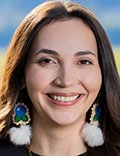, 2025-06-25 12:59:00
Canada’s Indigenous History Month is an appropriate time to examine the efforts that the Canadian Institutes of Health Research (CIHR) are taking to improve Indigenous health trajectories within the First Nations, Inuit, and Métis communities. Many of these efforts flow through the agency’s Indigenous Healthy Life Trajectories Initiative (I-HeLTI), which is dedicated to creating transparent, community-first approaches to research and healthcare delivery.
“The goal of I-HeLTI is to identify culturally strengthening strategies crucial for improving maternal and child health outcomes in Indigenous communities,” Chelsea Gabel, PhD, scientific director of the Institute of Indigenous Peoples’ Health at CIHR and associate professor of Indigenous studies and health, aging, and society at McMaster University in Hamilton, Ontario, told Medscape Medical News. Gabel is a Red River Métis.

“Research shows that First Nations, Inuit, and Métis people experience significantly higher rates of noncommunicable diseases, as well as issues around maternal health and poor health outcomes in general,” she said.
Research on Indigenous communities historically has focused on deficits. “This means that it’s focused on a larger problem (eg, Indigenous people are more likely to have diabetes or drink more) vs looking at [the role played by] factors like intergenerational trauma, the residential schools system, and social determinants of health.” I-HeLTI aims to change this focus.
Community-Integrated Care
I-HeLTI is based on a Developmental Origins of Health and Disease approach, which suggests that environmental factors (namely social determinants of health like poverty, racism, housing, and geographical location) interact with genes during conception, the pre- and postnatal and infancy periods, and early childhood to affect later health outcomes.
The initiative has an international component in countries like China, India, and South Africa, as well as the World Health Organization. Several Indigenous projects are active in Canada, including Aunties Within Reach (AWR) in the Wood Buffalo region in Alberta.
AWR is a collaborative partnership between the University of Alberta’s Collaborative Applied Research for Equity in Health Policy and Systems (CARE) Lab and the Ihkapaskwa Collective. The CARE Lab is an applied health policy systems team that studies and designs, implements, and evaluates programs with community partners to develop locally tailored, context-based solutions. The Ihkapaskwa Collective is an Indigenous-founded and Indigenous-led nonprofit focused on providing accessible, community-centered reproductive healthcare.
“AWR is an excellent model of community-integrated care,” said Stephanie Montesanti, PhD, associate professor of public health at the University of Alberta, Edmonton, and head of the CARE Lab. The partnership is not only delivering reproductive health services directly in the community but also engaging with providers across health and social sectors, she explained.

When Montesanti joined I-HeLTI, she wanted to explore the opportunity to bring the program to the Wood Buffalo regional municipality, where Sheena Bradley, Ihkapaskwa founder and executive director, had been working.

Bradley, a Cree-Métis full-spectrum birth worker and clinical herbalist, cofounded AWR with Maddie Amyotte, a Cree-Métis registered Indigenous midwife, and Shelby Weiss, a Sturgeon Bay Cree full-spectrum birth worker. Bradley said that AWR provides reproductive health support that mirrors the way that traditional “aunties” would, when and where mothers, families, and the community needed it most. But funding has been tight.
“The CARE Lab reached out to us to partner on the I-HeLTI initiative, and we spent a good portion of a year building relationships and learning what the research would look like in our community,” said Bradley. “Would it be led by us and families and elders in the community?” she said.
“There’s a few elders on that team from various communities that are really helping guide [the CARE Lab’s] research and what they see fits as research being brought into the community,” said Bradley. “But there’s also natural guidance from our grandmothers, the elders that we work with every day, and the families we support. That’s what is meant by the phrase ‘guided by community.’”
The goal was to bridge the gap and improve access to reproductive health services, said Montesanti.
Indigenous Birth Practices
Since the 1960s, Canada has relied on maternal evacuation, which transfers Indigenous pregnant women from Canada’s rural, remote regions to urban hospitals to give birth. The strategy was created to address disparities in maternal and child outcomes. It has been linked, however, to emotional, social, and cultural harms, as well as maternal and neonatal infections.
“Within our municipality, which is massive in land size and home to 13 First Nations and Métis communities, a lot of mothers are evacuated for birth, leave their home community and their support systems to come into town, where they are then scrutinized for not having healthy supports,” said Bradley.
“As soon as they leave their nation and go into town to deliver their baby, they are placed under Provincial rather than Tribal Child Family Services. It’s hard to navigate between the two and figure out who’s responsible for who and what,” she added. “You can imagine when people are coming from a remote community to an urban center and hospital setting, it’s going to be uncomfortable.”
“These services are offered by the mainstream health system, which is not necessarily culturally safe or culturally relevant,” added Montesanti. On the other hand, full-spectrum birth workers are both aunties and care providers. “They play important roles around social, cultural, and outreach support, as well as [providing] mentorship and traditional teachings related to reproductive health, like breast or infant feeding, postpartum care, mental health and well-being, and social well-being,” she explained.
The CARE Lab ensures an ongoing cycle of implementation learning (ie, identifying best practices, linking volunteers to them, identifying similar programs that have been implemented in other contexts, and bringing the lessons they offer to AWR). In alignment with I-HeLTI requirements, the lab also is creating a pregnancy cohort.
AWR is stretched to capacity. In addition to Bradley and Amyotte, a Métis nurse practitioner runs a private primary care practice and has hospital privileges in Fort McMurray. Carlee Myette, a Métis auntie navigator or all-around advocate, guides families through basic needs supports like housing, food, mental health referrals, and navigating Child and Family Services. Kaylen Duke, a Chipewyan Prairie Dene, is community engagement coordinator and research assistant and operates as a liaison between the Aunties and the CARE Lab team, which, in addition to Montesanti, includes research assistant Nicole Orji, a First Nations Iroquois.

“What can be a model for other communities is the fact that AWR is helping to reclaim traditional practices and knowledge; it’s bringing culture and ceremony back to birth,” said Orji.
“Many of our nations are matrilineal. Through the process of reconciliation and the mainstream Western medicine model, we have lost not just our mothers, but Indigenous people in general have lost our autonomy, choices, rights, and control over our reproductive freedoms,” she said.
“A lot of the work that the Aunties Within Reach program is doing is repairing some of those harms,” said Orji.

Gabel, Montesanti, Orji, Bradley, and Duke reported having no relevant financial relationships.
Liz Scherer is a health journalist who frequently covers Canadian and EU health and health equity issues.


